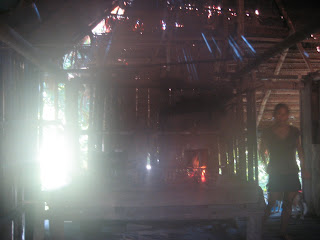First, Campbell, Julie and five community members from Brillo Nuevo searched the surrounding forest for copal trees with resin lumps. These lumps form when weevil larvae eat through the bark, enabling the tree´s resin to ooze out. This resin is perfect for caulking boats, and also for creating fragrant oils.
The team used GPS to map its progress and to divide the forest into lots. As a result, we now know how many copal trees are in each 100m X 1000m lot, and the community will be able to use this information in the future. When the team found a copal tree, they tagged it and harvested about half of the resin lumps. They made sure not to collect more than half, because that might endanger the weevil larvae and any other species that relies on the resin lumps for its survival.

You got to hand it to this team - this work was not easy. They searched the forest for at least seven hours per day for five days. I joined them on the first day, and it was exhausting! We tried to stick to trails as much as possible, but for most of the search we had to bushwack it through the jungle. And there were obstacles, like angry wasp nests and thin slippery logs that we had to navigate to cross the rivers.
We collected a total of about 10 kg of resin lumps. Then Julie and Campbell documented the weight and type of the resin lump - fresh or dry. Julie picked through the resin for hours in search of weevil larvae and other bugs. Meanwhile, Campbell collected dozens of samples of resin and bugs in tiny glass bottles.
And then came the most exciting part - the distillation! This is when we get to transform sticky resin into perfume. Campbell brought along a monstrous copper distillator that we affectionately call "mother." We heated mother up on a gas stove, and she gave birth. After about eight hours and a lot of anger from mother in the form of escaping vapor, mother sucked the oil out of the resin and neatly spewed it out into the glass flask.

 We looked like crazy scientists, tending to mother in the dark with our headlamps. Everytime she coughed up a little steam from her seams, we sealed her up with yuca mass. When the yuca mass began to dry and fall off, we tried silicone and a plumber´s sealant. Eventually she stopped fuming.
We looked like crazy scientists, tending to mother in the dark with our headlamps. Everytime she coughed up a little steam from her seams, we sealed her up with yuca mass. When the yuca mass began to dry and fall off, we tried silicone and a plumber´s sealant. Eventually she stopped fuming.We carried out four experiments - two with dry resin, and two with fresh resin. We got an average yield of oil of about 5%, which is approximately what Campbell expected.
I think this oil has potential as a perfume. It smells like a prarie in bloom with a hint of earth, like a grassland just before a rainstorm.
Now we have some more questions to answer:
Is there a market for this oil?
If there is a market, how can the community manage the harvest of copal resin lumps to ensure that the production of essential oil is economically and ecologically sustainable?
Find our more about CACE´s copal resin research.
Photos © Campbell Plo9wden / Center for Amazon Community Ecology














